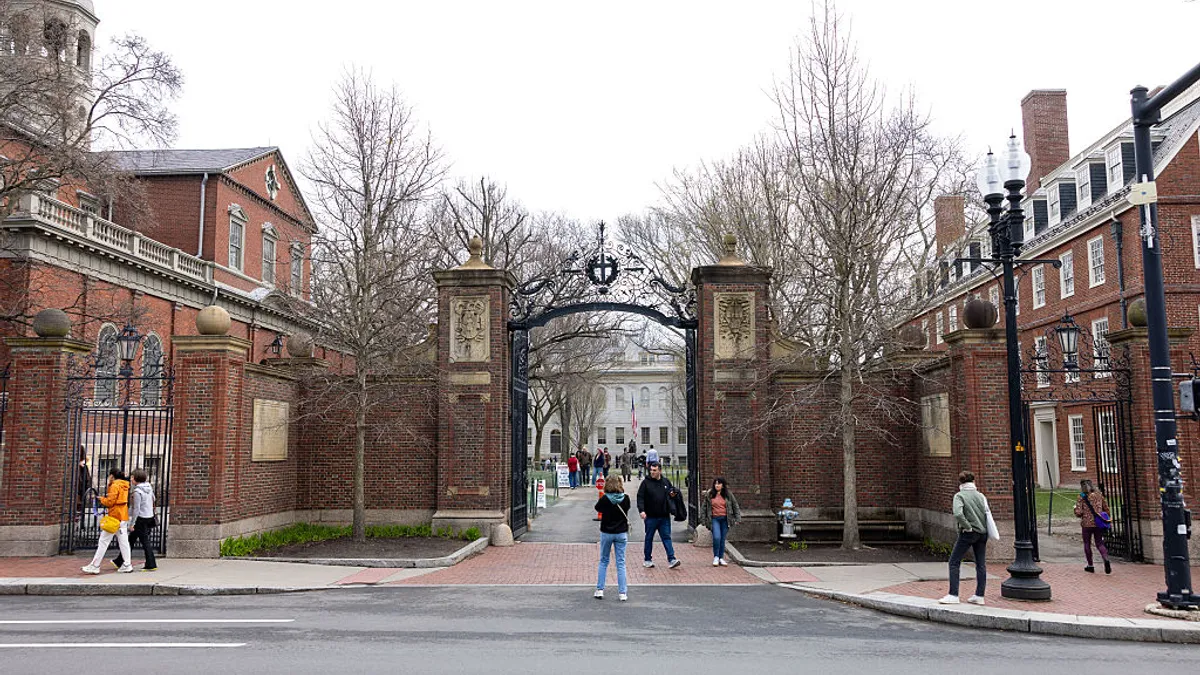At a time when colleges and universities are reeling from the financial fallout of the COVID-19 pandemic, a $3 billion pot of new federal money to help governors stabilize their education programs could help cushion the blow. But whether higher education institutions will see any of that money — much less decide what they will spend it on — will vary greatly by state.
Education Dive's analysis of state applications for the Governor's Emergency Education Relief (GEER) Fund shows widely different plans for the funds, which come with few strings attached. For example, New Jersey plans to use all of its allotment, nearly $69 million, for higher ed. Delaware, its neighbor to the south, doesn't expect to spend any of its $7.9 million share on colleges.
The amount states receive, which is based on their count of children and young adults, varies widely, from $4.5 million in Vermont to $355.2 million in California.
Most states plan to split the money they get between K-12 and higher ed. Few provided concrete numbers to the U.S. Department of Education, which administers the grant, but they did describe the ways they hope to use the windfall to address some of the myriad problems caused by the coronavirus.
Jen Mishory, a senior fellow and senior policy advisor at The Century Foundation, who has also reviewed the applications, said states offered few details about how they would divide the money between K-12 and higher ed.
"For the most part, it's still unclear," she said. States will have to keep the federal government updated about how they spend the money in the coming months. "We're hopeful that that will provide more information, because right now the department approved all these applications and a lot of them are lacking in detail."
The GEER grants are a relatively small part of the $2 trillion economic rescue package Congress passed in March, called the Coronavirus Aid, Relief, and Economic Security (CARES) Act. And they are not the only funds from that package that can be used to shore up colleges' finances. But it is one of the most flexible sources of money the legislation affords education.
Governors identified a wide range of priorities for the GEER money. Helping institutions move to remote learning was a major concern for many states. Others focused on shoring up the bottom lines of hard-hit institutions, beefing up student financial aid, improving workforce training or ensuring that students from historically underserved communities can continue with their education.
"This is crisis and emergency funding," said Alaina DeSalvo, competitive grants administrator for the Minnesota Office of Higher Education. "While we are trying to provide a little bit of relief for these institutions, it's still not meant to be sustained for long periods of time. We're trying to help them get up to speed so they're able to provide education for their students."
Thomas Harnisch, vice president for government relations at the State Higher Education Executive Officers Association (SHEEO), cautioned that how governors decide to use the GEER money should be considered in a broader context. Some states, for example, mitigated cuts to higher ed funding with additional federal money.
"This money can't be considered as standalone (funding), but rather part of a larger approach by the governors to fund education in their states," he said.
How states will use the funds
Broader support for institutions was the exception rather than the rule.
New Jersey Gov. Phil Murphy, a Democrat, plans to use his state's entire allotment for higher ed. The state's Office of the Secretary of Higher Education will distribute the funds using emergency grants that will take into account how much extra money public colleges and universities have had to spend as a result of the pandemic.
Although Georgia did not offer much detail in its application, it did note that the University System of Georgia lost $142 million during the spring semester and is expected to lose as much as $350 million through the summer because of the coronavirus. "The State will consider relief for these losses to be a priority for GEER funds as our state works through this unprecedented crisis," Georgia officials wrote in their application.
Georgia would consider applications from private institutions, but it planned to dole out grants based on which institutions were most significantly impacted by the virus.
Kansas officials said they would focus on colleges — and particularly their ability to continue instruction online — when distributing the state's share of the funds. That could include providing students with access to hardware and expanding access to videoconferencing and online learning software to support classes and extracurricular activities.
Administrators from several states indicated that they would use the money to help students from groups that are often overlooked.
Higher ed institutions in Minnesota will be able to apply for $5 million of competitive grants funded by the GEER program. The institutions are encouraged to show how they would use the money to train future teachers and faculty from underserved communities, or how they could help "lower-income students, students of color, indigenous students, and students with disabilities" access technology for remote learning. Minnesota is also giving $100,000 grants to each of three tribal community colleges.
Illinois' application says the state developed a methodology for distributing the GEER funds that would support institutions aiming to "attract, retain and graduate the most vulnerable students." Those include "low-income students, rural students, and students of color who are graduating from high school" and plan to attend college, officials wrote.
Likewise, colleges in Oregon are being asked to use an "equity lens" when describing how they would use the money to reach historically underserved and economically disadvantaged students. The emergency funding would be used to help those students take steps toward completing their credential, including through remote instruction, they explain in their application.
In Nevada, education officials told the federal government that several state agencies would work together "to increase connectivity to combat the digital divide in both rural areas, where there is no or limited internet connectivity for students, and in urban areas where there are limitations due to financial instability, housing insecurity, device access, etc."
The funds, they wrote in their application, "will ensure that our highest-need students in public and private institutions of higher education can access remote learning reliably."
Tennessee officials said the state would distribute GEER grants to institutions "formulaically based on each institution's proportionate share of low-income students."
And in Indiana, state officials said they planned to distribute money to improve remote learning by using "data-driven equity indicators and current technology access data."
"This money can't be considered as standalone (funding), but rather part of a larger approach by the governors to fund education in their states."

Thomas Harnisch
Vice president for government relations, State Higher Education Executive Officers Association
Several other states said they would use the grant money to support workforce development programs.
North Dakota Gov. Doug Burgum, a Republican, said the state planned to use some of the money to improve distance learning and to prepare for "the new normal" related to the coronavirus at its public colleges. The state's application stressed the role of its higher ed institutions in training "the post COVID-19 workforce" and providing "citizens with resources to reenter the workforce."
The North Dakota University System plans to "return to some semblance of regular instruction and campus life" in the fall, according to a statement this spring from Nick Hacker, chair of the State Board of Higher Education, and Mark Hagerott, chancellor of the North Dakota University System.
Arkansas also promised to expand or upgrade its workforce training initiatives.
Community colleges are a focus for Wyoming. Officials there wrote that adult education centers "need to be able to finance the costs associated with maintaining new virtual classrooms and implementing protocols which lead to successful completions."
That means adding money for running testing centers, purchasing standardized assessments, obtaining personal protective equipment and other health-related gear, buying licenses for online learning platforms and training instructors to "successfully manage traditional, hybrid, and virtual classrooms," they explained.
A model for future support?
Higher ed institutions — particularly public colleges and universities — still need more federal help, said Mishory, from The Century Foundation. She and two dozen groups called on congressional leaders in April to spend $46 billion for public higher ed. Other higher ed organizations have pressed federal lawmakers for a similar sum.
She doesn't blame Congress for giving governors the discretion to divide the GEER money between K-12 schools and higher ed. "We know this was a quick response to an urgent situation. Certainly, governors are going to look and see where that need is in their state," Mishory said. "Going forward, ensuring that both are funded through a federal response is going to be important."
But states had to agree to maintain current funding levels for higher ed in order to qualify for the GEER money, unless the U.S. education secretary finds those states to have experienced a "precipitous decline in financial resources." Depending on how the federal government interprets that exception, some states could forfeit their GEER funds if they cut higher ed support, SHEEO's Harnisch said.
He was encouraged, however, that the federal government was supporting higher ed through state governments. That would help to ensure the institutions and state and federal governments are working toward shared goals and interests, he said, calling it a model for future collaborations.
"We want to try to establish a state-federal partnership (for higher ed) ... not just right now in this COVID-19 period, but longer-term," Harnisch said. "We want to work to align funding with the federal government and states, to make sure they're not working at cross purposes."





















